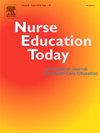Effectiveness of immersive virtual reality in nursing education for nursing students and nursing staffs: A systematic review and meta-analysis
IF 3.6
2区 医学
Q1 EDUCATION, SCIENTIFIC DISCIPLINES
引用次数: 0
Abstract
Aim
This study evaluates the effectiveness of immersive virtual reality (VR) in nursing education, with a focus on its impact on knowledge acquisition, skill development, and problem-solving abilities among nursing students and nursing staff. In addition, it examines the effects of different levels of VR immersion across various learner populations, as well as potential side effects.
Background
Traditional nursing education often lacks realistic clinical settings, leading to “reality shock” during clinical practice. VR provides a safe environment for learners to simulate clinical scenarios and practice without fear of errors. However, the effects of varying levels of VR immersion remain unclear.
Design
Systematic review and meta-analysis.
Review Methods
A systematic search of the Cochrane Library, Embase, PubMed, CINAHL, and Airiti Library was conducted for Chinese and English studies published up to October 22, 2024, following PRISMA guidelines. Risk of bias was assessed using RoB 2.0 and ROBINS-I tools, while evidence quality was evaluated with GRADE. Meta-analyses used standardized mean differences (SMD) and a significance threshold of p < .05.
Results
Twenty-four studies involving 1812 participants showed that VR significantly improved knowledge (small effect, SMD = 0.34, 95 % CI: 0.06–0.62, p = .02), skills (medium effect, SMD = 0.72, 95 % CI: 0.35–1.10, p = .0002), and problem-solving abilities (large effect, SMD = 1.46, 95 % CI: 0.65–2.28, p = .0004). Fully immersive VR was particularly effective in enhancing nursing students' knowledge (SMD = 0.41, 95 % CI: 0.11–0.70, p = .007), while semi-immersive VR was more effective for nursing staff (SMD = 1.34, 95 % CI: 0.85–1.84, p < .001). Six of the 24 studies examined side effects, with four reporting adverse reactions. The most common side effect was motion sickness, manifesting as nausea, vomiting, and cold sweats.
Conclusions
Immersive VR is an effective tool for improving knowledge, skills, and problem-solving abilities in nursing education, with fully immersive VR benefiting students and semi-immersive VR benefiting staff. Despite its advantages, potential side effects like motion sickness should be considered. VR presents a promising, realistic, and repeatable approach to nursing education.
求助全文
约1分钟内获得全文
求助全文
来源期刊

Nurse Education Today
医学-护理
CiteScore
6.90
自引率
12.80%
发文量
349
审稿时长
58 days
期刊介绍:
Nurse Education Today is the leading international journal providing a forum for the publication of high quality original research, review and debate in the discussion of nursing, midwifery and interprofessional health care education, publishing papers which contribute to the advancement of educational theory and pedagogy that support the evidence-based practice for educationalists worldwide. The journal stimulates and values critical scholarly debate on issues that have strategic relevance for leaders of health care education.
The journal publishes the highest quality scholarly contributions reflecting the diversity of people, health and education systems worldwide, by publishing research that employs rigorous methodology as well as by publishing papers that highlight the theoretical underpinnings of education and systems globally. The journal will publish papers that show depth, rigour, originality and high standards of presentation, in particular, work that is original, analytical and constructively critical of both previous work and current initiatives.
Authors are invited to submit original research, systematic and scholarly reviews, and critical papers which will stimulate debate on research, policy, theory or philosophy of nursing and related health care education, and which will meet and develop the journal''s high academic and ethical standards.
 求助内容:
求助内容: 应助结果提醒方式:
应助结果提醒方式:


